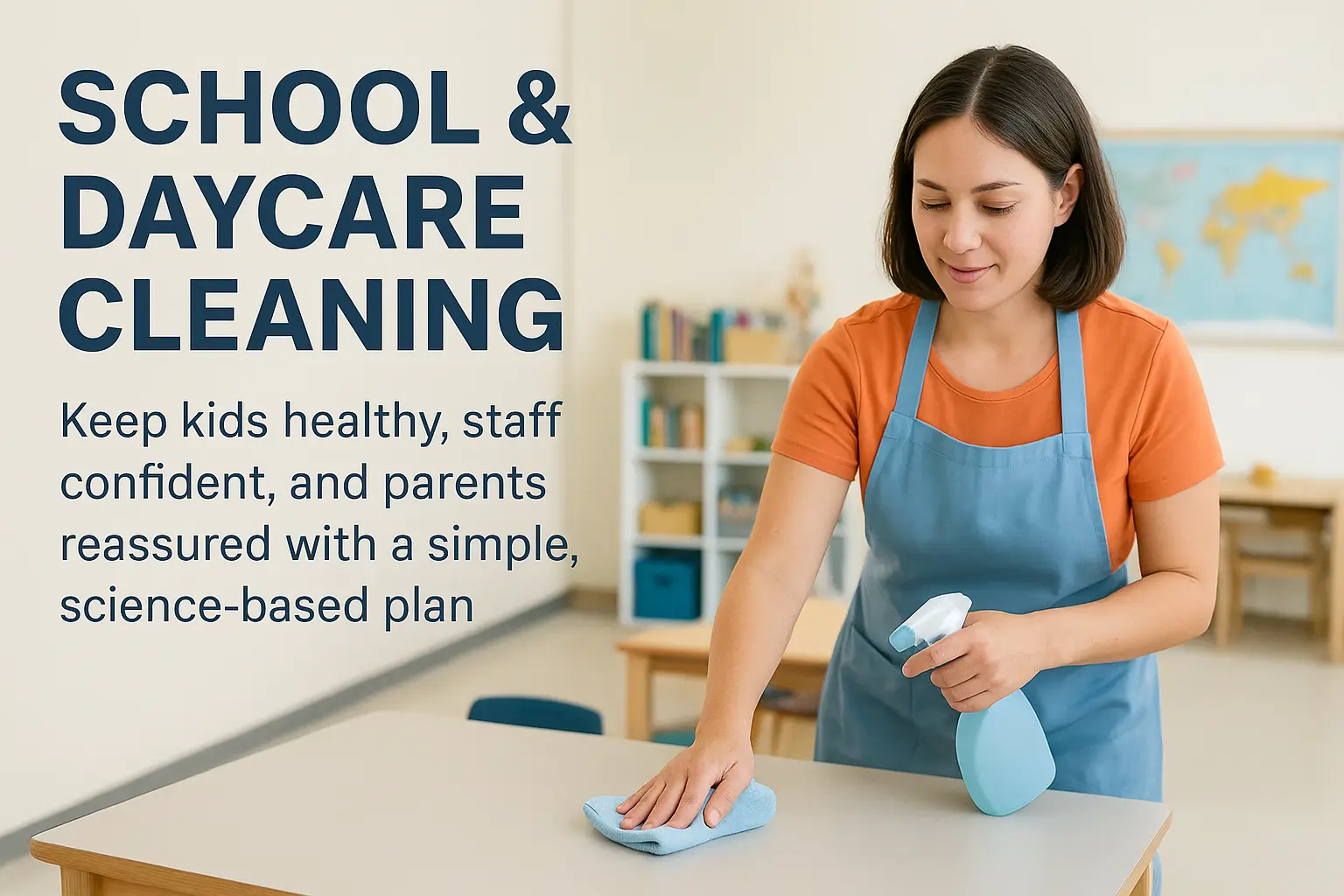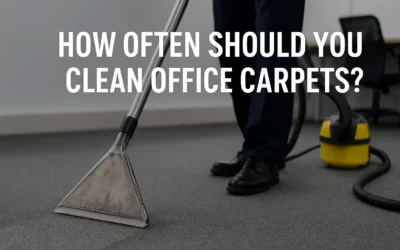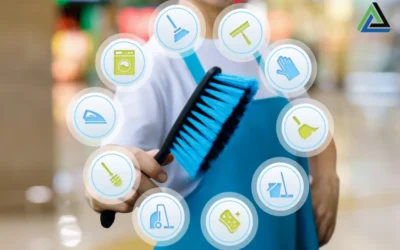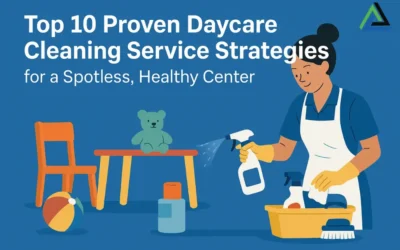Keep kids healthy, staff confident, and parents reassured with a simple, science-based plan. This guide shows you the high-touch hotspots where germs spread fastest and what to use that’s effective and child-safe.
- Focus on hands and surfaces that hands touch: door handles, desks, toys, faucets, rails, switches, tablets.
- Use approved, child-safe disinfectants/sanitizers, and follow the label’s dwell time.
- Build a daily + weekly schedule and log it. Rotate/clean toys, color-code cloths, ventilate rooms.
Why “high-touch” matters
Children touch many surfaces in minutes (and then their face). Viruses and bacteria can survive on plastics, steel, and screens long enough to spread through a class. Targeting high-touch hotspots yields the greatest health return for your effort.
Map of High-Touch Hotspots (Room by Room)
Classroom Cleaning
- Desks, chair backs, light switches, door handles
- Shared supplies: markers, scissors, caddies
- Tech: tablets, keyboards, interactive boards
- Nap mats & cots (daycare/early years): tops, straps, storage bins
Play Areas (Indoor)
- Toys: plastic blocks, dolls, cars, puzzle pieces
- Hard surfaces: shelves, play kitchens, ride-ons
- Soft items: plush toys, dress-up clothes (rotate/limit; launder often)
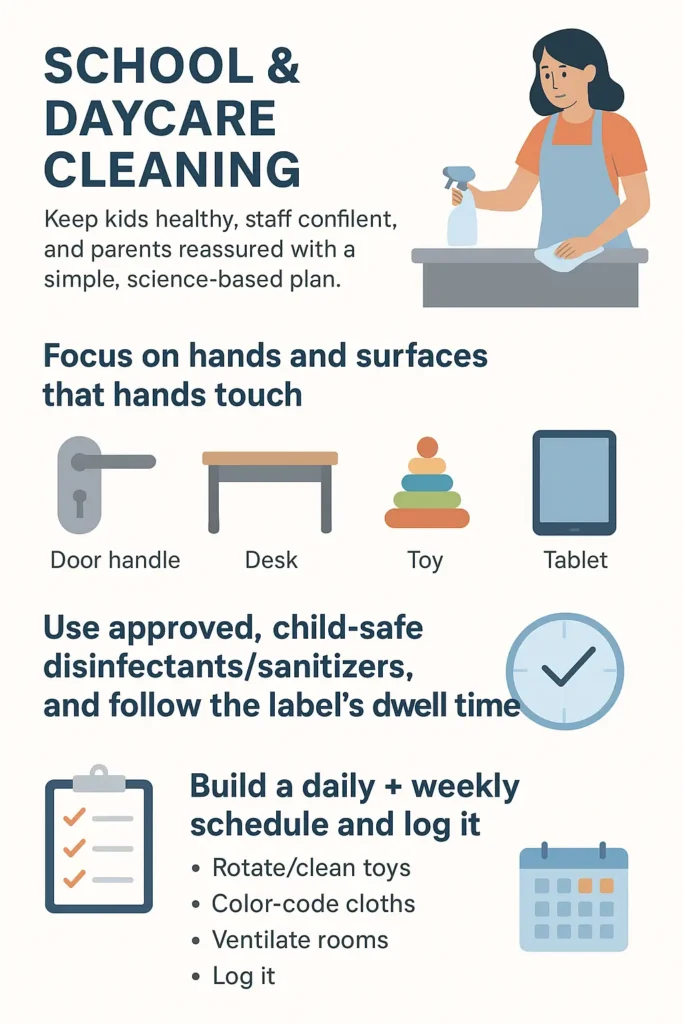
Bathroom Cleaning
- Faucets, flush handles, door locks
- Soap & paper dispensers
- Sink counters, toilet seats (front/sides)
Dining/Cafeteria Cleaning
- Tables & chair tops/backs
- Tray rails, fridge/microwave handles
- POS keypads (if any)
Corridors & Common Areas
- Handrails, elevator buttons
- Entry door push plates
- Reception desk surfaces, pens
Staff Rooms & Offices
- Shared keyboards/mice, phones
- Kettle/coffee machine buttons, fridge handles
School Buses/Vans
- Door handles, window latches
- Seat tops/backs, grab rails
Choosing Safe & Effective Products
Cleaner vs. Sanitizer vs. Disinfectant
- Cleaner: removes dirt; not designed to kill germs.
- Sanitizer: reduces germs to safe levels (good for food-contact surfaces).
- Disinfectant: kills listed pathogens (best for bathrooms, illness outbreaks).
Use cleaner first if surfaces are visibly dirty, then sanitizer/disinfectant as needed.
What “safe” means in schools/daycares
- Look for recognized approvals/certifications in your country (e.g., government-approved disinfectants; eco/health labels like Green Seal/EcoLogo/Safer Choice where applicable).
- Prefer low-odor, non-irritating actives (many modern hydrogen-peroxide or quaternary-based products have school-safe versions).
- Fragrance-free or low-fragrance to reduce asthma/allergy triggers.
- Food-contact safe sanitizer for cafeteria tables (no rinse required when used as directed).
Critical usage rules
- Dwell/contact time matters: the surface must stay wet for the full label time.
- Right dilution: use measured dosing; never “stronger for safety.”
- Surface compatibility: test first on screens, painted wood, soft plastics.
- Storage & labeling: lock chemicals away; use original or clearly labeled bottles.
- Ventilation & PPE: open windows/turn on exhaust; gloves for staff; wash hands after.
Methods That Raise Quality (and Lower Risk)
Color-coded microfiber (no cross-contamination)
- Red = toilets/urinals only
- Yellow = restroom sinks/partitions
- Blue = classroom/general
- Green = food areas
Wash cloths daily; keep sets separate.
Right order of work
- Remove clutter/trash.
- High-to-low dusting (vents, ledges).
- Clean surfaces (visible soil).
- Disinfect/sanitize high-touch areas (respect dwell time).
- Floors last (vacuum/mop with clean solution).
Toys: simple, safe routines
- Hard plastic: wash with mild detergent; sanitize per label (or run through dishwasher if manufacturer allows).
- Soft toys: machine-wash hot; dry completely; consider limiting plush in peak illness season.
- Rotation: split toys into sets; one in use, one being cleaned/dried.
Sample Daily & Weekly Schedule
| Area | Hotspots | Frequency | Method | Product Type |
| Classrooms | Desks, chairs, switches, door handles, tablets | Daily; tablets after each group | Wipe clean → disinfect (full dwell) | School-approved disinfectant |
| Play areas | Hard toys, shelves, ride-ons | Daily | Clean → sanitize/disinfect | Child-safe sanitizer/disinfectant |
| Plush/soft items | Dress-up, plush toys | 2–3×/week (or rotate) | Machine-wash/dry | Laundry detergent |
| Bathrooms | Faucets, flush handles, seats, locks, dispensers | 2× daily (more if heavy use) | Clean → disinfect | Disinfectant (bathroom safe) |
| Cafeteria | Tables, chair backs, tray rails | Before/after meals | Food-contact sanitizer (no rinse as directed) | Approved sanitizer |
| Entry & halls | Rails, buttons, door plates | Daily | Wipe → disinfect | Disinfectant |
| Buses/vans | Seat tops, rails, door handles | Daily (after route) | Wipe → disinfect | Disinfectant |
Keep a cleaning log per room/vehicle: date, time, staff initials, products used.
Extra Credit: Outbreak Response (flu, stomach bug, etc.)
- Increase frequency on hotspots (2–4× daily in affected rooms).
- Use a disinfectant with the right kill claims for the pathogen class (per label).
- Isolate & bag heavily soiled items; clean/LAUNDER promptly.
- Suspend plush toys temporarily and increase ventilation.
- Communicate with parents/staff: what changed, for how long.
Parent- and Staff-Friendly Communication
- Post a one-page “How We Keep Classrooms Healthy”: schedule, products (with safety notes), contact times, and what families can do (hand hygiene, sick-day policy).
- Offer MSDS/SDS on request and list common allergens (e.g., fragrances).
Quick Procurement Checklist
- Government-approved school-safe disinfectant + food-contact sanitizer
- Measured-dose bottles/pumps for accurate dilution
- Microfiber cloths (color-coded) + labeled storage
- Spray bottles with clear labels; closed carts; gloves
- Tablet/screen-safe wipes as per device maker
- Cleaning logs (printed or app)
Wrap-up
You don’t need harsh chemicals everywhere—you need the right process, targeted hotspots, and compliant products. Do the basics consistently, document them, an

